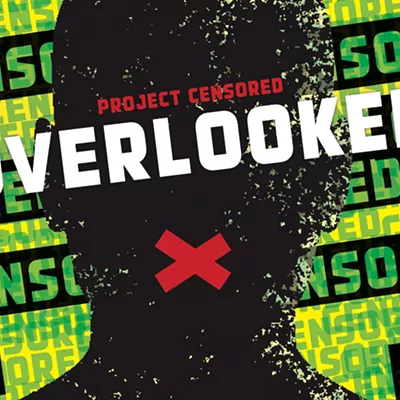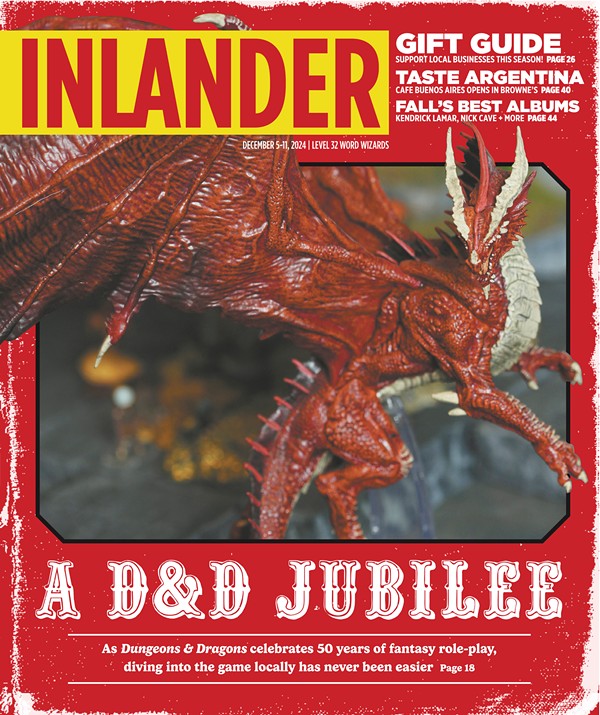Who Let the Dogs Tap?
[
{
"name": "Broadstreet - Instory",
"component": "25846487",
"insertPoint": "4",
"requiredCountToDisplay": "4"
},{
"name": "Broadstreet - Empower Local",
"component": "27852456",
"insertPoint": "8",
"requiredCountToDisplay": "8"
},{
"name": "Broadstreet - Instory",
"component": "25846487",
"insertPoint": "12",
"requiredCountToDisplay": "12"
},{
"name": "Broadstreet - Instory - 728x90 / 970x250",
"component": "27852677",
"insertPoint": "18",
"requiredCountToDisplay": "18"
},{
"name": "Broadstreet - Instory",
"component": "25846487",
"insertPoint": "5th",
"startingPoint": "23",
"requiredCountToDisplay": "24",
"maxInsertions": 100
}
]
by Michael Bowen & r & & r & & lt;span class= "dropcap " & T & lt;/span & ap Dogs opens the same way 42nd Street does -- with the curtain rising, just barely, to reveal swarms of madly tapping feet.
Except that in Tap Dogs, construction workers are stomping their feet in work boots. And then, by streaming ropes of water onto the stage, they simulate what Rover likes to do against trees. They're marking a new kind of tap dance territory. These are Tap Dogs, dog.
In a high-energy, 75-minute show, a half-dozen hoofers in jeans and flannel shirts tap dance while dribbling basketballs and building a scaffold, while wearing Wellington boots in a water trough, while suspended upside down in a harness. Compared to its forebears, Tap Dogs represents a natural progression:
& lt;ul & & lt;li & Tap dance began in mid-19th-century New York by blending African improvisation with Irish jigs and English clog dancing. But Tap Dogs was started by some dance-minded steel workers in a mill town just north of Sydney, Australia. & lt;/li & & lt;li & In movies of the 1930s like The Gay Divorcee and Top Hat, Fred Astaire and Ginger Rogers added the flowing limbs of ballroom elegance to the legs-only hoofing of tap. But the Tap Dogs are guys. They don't wear top hats and they don't do elegance. "We use industrial grinders, and there's steel all over the set," says Josh Cyr, a nine-year veteran of the show. "The hand grinders with tap dancing, all in rhythm -- that's what this show is all about." & lt;li & In An American in Paris and Singin' in the Rain, Gene Kelly added classical ballet elements to his tap displays. He leaned on a lamppost and exulted in a downpour. But in Tap Dogs, they haul on buckets, splash water all over the stage, do a nice little soft shoe -- then pull on enormous gumboots and leap into that water trough. "What we're showing is that you don't need taps on your feet to tap dance," says Cyr. & lt;/li & & lt;/ul &
Tap Dogs, then, represents an evolution in tap -- from graceful, cooperative elegance to in-your-face, gritty competition.
Except that sometimes tap dance isn't evolving upwards so much as it's devolving downwards -- as when Cyr attempts to teach someone how to tap dance. Over the phone. Someone like me.
Inlander: OK, I'm a reasonably athletic guy but no dancer. Let's pretend one of your guys sprains an ankle and needs to leave the stage for three minutes to have it taped. Teach me the steps right now, because I wanna be a star! & r & Josh Cyr: Well, I'd get you running in rhythm -- pick up your left foot, then your right. Now really fast -- faster, really quick -- left, right, left, right.
Once you're in rhythm, I'd get you in the group doing the shuffle. [The shuffle: "Standing on one leg, the other is brushed out by sliding the toe of the shoe against the floor, then brushed back in." You can make the step faster by making smaller movements closer in to the body -- you can shuffle from the hip or even from the ankle.] Nice and slow, then quicker -- twice on each foot, still running in slow motion, switching legs. Once we have you into the shuffle, if we just have three minutes, we'd keep you in the group and then we'd just point to you.
Inlander: Is this the chance for my big solo? & r & Cyr: Oh, sure. And you'd keep the heel-to-toe, heel-to-toe....
Inlander: Is that the tapping part? & r & Cyr: Well, in this routine, the heels never touch the floor, but if you did drop the heel, you'd be making it harder and more complex.
Inlander: Yeah, like I'm ready for that. I'm getting the impression that this show is for straight guys who don't like dance or know anything about it. & r & Cyr: We get a lot of guys who were dragged to the theater, or they just decided to take their ladies out without really knowing what they were getting into.
Inlander: So what do the audiences like? What kind of people show up at the stage door? & r & Cyr: There was this Iranian woman one night -- she wanted us to bring the show to the Middle East. And there are the little dance kids -- little boys who wanna take tap -- girls, same thing. There are [teenage] girls with their dates, and guys who actually come up and congratulate us. Or a bunch of 21-year-old girls. [laughs] Sometimes they're a bit older.
Inlander: How do the audiences vary by region? Aren't some of them less interested in your tap dance technique than in ... other stuff? & r & Cyr: In North America, the audiences are more judgmental of the tap dancing itself. In other places, especially in Europe and in Asia, they're more into the spectacle of it all -- the lights and the costumes. In North America, there's a lot more people with tap training. We get a lot of dance teachers, and they take their kids, and they tell them, "See, they're doing the shuffle -- they're doing everything I've taught you.' And the kids go, 'Yeah, I gotta do that.'"
One bit that all the kids wanna do -- a real crowd-pleaser -- is the "steam train with dry ice" routine. But let Cyr describe it:
"Our surface for that particular part is all metal," he says. "So, we're dancing, and the house goes black, but we're still dancing. We do a tap step, heel to toe -- imagine rocking back and forth onto your heels, mixed in with a lot of steps. If you can imagine, on metal, it sounds a lot like a train. Then we line up and go one count off each other, throw in some accents -- and the way the choreography is done, the lights slowly come up, and what you see is this big headlight. And we come through the dry ice -- almost snake-like, as if the train is going around a corner, but it builds and builds and then it just stops. And then it goes again. It looks like it's turning a couple of corners, but it's always coming at you."
The junkyard Dogs are growling. On Tuesday night, they'll hop on a freight train headed straight for your lap.
Tap Dogs will growl on Tuesday, Feb. 21, at 7:30 pm at the Opera House, 334 W. Spokane Falls Blvd. Tickets: $30-$45. Visit www.tapdogs.com or call 325-SEAT.
Except that in Tap Dogs, construction workers are stomping their feet in work boots. And then, by streaming ropes of water onto the stage, they simulate what Rover likes to do against trees. They're marking a new kind of tap dance territory. These are Tap Dogs, dog.
In a high-energy, 75-minute show, a half-dozen hoofers in jeans and flannel shirts tap dance while dribbling basketballs and building a scaffold, while wearing Wellington boots in a water trough, while suspended upside down in a harness. Compared to its forebears, Tap Dogs represents a natural progression:
& lt;ul & & lt;li & Tap dance began in mid-19th-century New York by blending African improvisation with Irish jigs and English clog dancing. But Tap Dogs was started by some dance-minded steel workers in a mill town just north of Sydney, Australia. & lt;/li & & lt;li & In movies of the 1930s like The Gay Divorcee and Top Hat, Fred Astaire and Ginger Rogers added the flowing limbs of ballroom elegance to the legs-only hoofing of tap. But the Tap Dogs are guys. They don't wear top hats and they don't do elegance. "We use industrial grinders, and there's steel all over the set," says Josh Cyr, a nine-year veteran of the show. "The hand grinders with tap dancing, all in rhythm -- that's what this show is all about." & lt;li & In An American in Paris and Singin' in the Rain, Gene Kelly added classical ballet elements to his tap displays. He leaned on a lamppost and exulted in a downpour. But in Tap Dogs, they haul on buckets, splash water all over the stage, do a nice little soft shoe -- then pull on enormous gumboots and leap into that water trough. "What we're showing is that you don't need taps on your feet to tap dance," says Cyr. & lt;/li & & lt;/ul &
Tap Dogs, then, represents an evolution in tap -- from graceful, cooperative elegance to in-your-face, gritty competition.
Except that sometimes tap dance isn't evolving upwards so much as it's devolving downwards -- as when Cyr attempts to teach someone how to tap dance. Over the phone. Someone like me.
Inlander: OK, I'm a reasonably athletic guy but no dancer. Let's pretend one of your guys sprains an ankle and needs to leave the stage for three minutes to have it taped. Teach me the steps right now, because I wanna be a star! & r & Josh Cyr: Well, I'd get you running in rhythm -- pick up your left foot, then your right. Now really fast -- faster, really quick -- left, right, left, right.
Once you're in rhythm, I'd get you in the group doing the shuffle. [The shuffle: "Standing on one leg, the other is brushed out by sliding the toe of the shoe against the floor, then brushed back in." You can make the step faster by making smaller movements closer in to the body -- you can shuffle from the hip or even from the ankle.] Nice and slow, then quicker -- twice on each foot, still running in slow motion, switching legs. Once we have you into the shuffle, if we just have three minutes, we'd keep you in the group and then we'd just point to you.
Inlander: Is this the chance for my big solo? & r & Cyr: Oh, sure. And you'd keep the heel-to-toe, heel-to-toe....
Inlander: Is that the tapping part? & r & Cyr: Well, in this routine, the heels never touch the floor, but if you did drop the heel, you'd be making it harder and more complex.
Inlander: Yeah, like I'm ready for that. I'm getting the impression that this show is for straight guys who don't like dance or know anything about it. & r & Cyr: We get a lot of guys who were dragged to the theater, or they just decided to take their ladies out without really knowing what they were getting into.
Inlander: So what do the audiences like? What kind of people show up at the stage door? & r & Cyr: There was this Iranian woman one night -- she wanted us to bring the show to the Middle East. And there are the little dance kids -- little boys who wanna take tap -- girls, same thing. There are [teenage] girls with their dates, and guys who actually come up and congratulate us. Or a bunch of 21-year-old girls. [laughs] Sometimes they're a bit older.
Inlander: How do the audiences vary by region? Aren't some of them less interested in your tap dance technique than in ... other stuff? & r & Cyr: In North America, the audiences are more judgmental of the tap dancing itself. In other places, especially in Europe and in Asia, they're more into the spectacle of it all -- the lights and the costumes. In North America, there's a lot more people with tap training. We get a lot of dance teachers, and they take their kids, and they tell them, "See, they're doing the shuffle -- they're doing everything I've taught you.' And the kids go, 'Yeah, I gotta do that.'"
One bit that all the kids wanna do -- a real crowd-pleaser -- is the "steam train with dry ice" routine. But let Cyr describe it:
"Our surface for that particular part is all metal," he says. "So, we're dancing, and the house goes black, but we're still dancing. We do a tap step, heel to toe -- imagine rocking back and forth onto your heels, mixed in with a lot of steps. If you can imagine, on metal, it sounds a lot like a train. Then we line up and go one count off each other, throw in some accents -- and the way the choreography is done, the lights slowly come up, and what you see is this big headlight. And we come through the dry ice -- almost snake-like, as if the train is going around a corner, but it builds and builds and then it just stops. And then it goes again. It looks like it's turning a couple of corners, but it's always coming at you."
The junkyard Dogs are growling. On Tuesday night, they'll hop on a freight train headed straight for your lap.
Tap Dogs will growl on Tuesday, Feb. 21, at 7:30 pm at the Opera House, 334 W. Spokane Falls Blvd. Tickets: $30-$45. Visit www.tapdogs.com or call 325-SEAT.
















